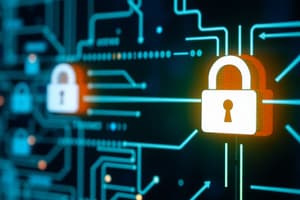Podcast
Questions and Answers
What is the main objective of Cryptography in the presence of adversaries?
What is the main objective of Cryptography in the presence of adversaries?
- Confidentiality
- Integrity
- Authenticity
- All of the above (correct)
What is the primary method to achieve Confidentiality in Cryptography?
What is the primary method to achieve Confidentiality in Cryptography?
Encryption
Which Cryptographic technique is used to ensure Integrity during message transmission?
Which Cryptographic technique is used to ensure Integrity during message transmission?
- Public Key Encryption
- Symmetric Encryption
- Digital Certificate
- Hashing (correct)
Symmetric Encryption uses the same key for _______ and _______.
Symmetric Encryption uses the same key for _______ and _______.
A Block Cipher encrypts data one block at a time.
A Block Cipher encrypts data one block at a time.
What is the purpose of a Certification Authority (CA)?
What is the purpose of a Certification Authority (CA)?
What is a Digital Certificate?
What is a Digital Certificate?
SSL/TLS uses both asymmetric and symmetric encryption to protect data-in-transit.
SSL/TLS uses both asymmetric and symmetric encryption to protect data-in-transit.
What does SSL/TLS use to establish a secure session between a client and a server?
What does SSL/TLS use to establish a secure session between a client and a server?
Pretty Good Privacy (PGP) combines ______ and ______ key technology.
Pretty Good Privacy (PGP) combines ______ and ______ key technology.
Flashcards are hidden until you start studying
Study Notes
Introduction to Cybersecurity
- Course outline for Cybersecurity Fundamentals:
- 14 topics including intrusion detection, network security, and cybersecurity standards
- Professor: Dr. Hatem Abdelkader, Dr. Mohamed Samir
- Evaluation: 30% exams, 20% practical work, 10% project, 40% final exam
Cryptography Basics
- Cryptography: the art of hidden writing, concealing the meaning of a message
- Encryption: converting plaintext to ciphertext
- Decryption: converting ciphertext to plaintext
- Confidentiality, Integrity, and Authenticity (CIA triad)
Cryptography Types
- Symmetric cryptography: same key for encryption and decryption
- Examples: Caesar Cipher, Block Ciphers, Stream Ciphers
- Asymmetric cryptography: different keys for encryption and decryption
- Examples: Public Key Cryptography, Digital Signatures
Symmetric Cryptography
- Block Ciphers: encrypt data in blocks (e.g., AES)
- Stream Ciphers: encrypt data in streams (e.g., RC4)
- Key strength: longer keys are more secure
Asymmetric Cryptography
- Public-key cryptography: public key for encryption, private key for decryption
- Digital signatures: ensure authenticity and integrity of messages
- Examples: RSA, Elliptic Curve Cryptography (ECC)
Hash Functions
- One-way functions: easy to compute, hard to reverse
- Message Digests: summaries of message content
- Hash algorithms: MD5, SHA, HMAC
Digital Signatures
- Digital certificates: verify identity and public key
- Digital signatures: ensure authenticity and integrity of messages
- Non-repudiation: sender cannot deny sending the message
Public Key Infrastructure (PKI)
- Certificate Authorities (CAs): issue digital certificates
- Digital certificates: contain public key, identity, and expiration date
- Verify identity and public key, ensure authenticity and integrity
Secure Sockets Layer/Transport Layer Security (SSL/TLS)
- Establish encrypted connections between client and server
- Asymmetric encryption for key exchange, symmetric encryption for data transfer
- Digital certificates verify server identity
Pretty Good Privacy (PGP)
- Provide privacy, integrity, authentication, and non-repudiation for email
- Use digital signatures and public-key encryption
- Encrypt data and authenticate sender
Reports and Assignments
- Report #1: RSA
- Report #2: Diffie-Hellman
- Due date: before next lecture
Studying That Suits You
Use AI to generate personalized quizzes and flashcards to suit your learning preferences.




